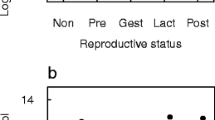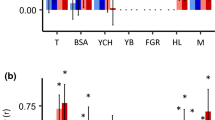Abstract
In the first-ever study of reproductive endocrinology in wild male giant pandas (Ailuropoda melanoleuca), we provide new insights into the reproductive ecology of the species. We tracked and observed pandas in Foping Nature Reserve of the Qinling Mountains for 3 years, collecting fecal samples for testosterone metabolite analysis and data on reproductive activity. Males encountered multiple potential mates and competed for reproductive access to females. Male testosterone metabolites increased in February, peaked in March and April, and fell back to baseline after the mating season. However, males did not maintain a high testosterone level throughout the mating season. Male testosterone instead peaked during encounters with potential mates and declined between encounters. These results indicate that testicular activity is typically dormant until mobilized by interactions with females and potentially by interactions with male competitors. This suggests that male pandas may be energetically constrained, elevating testosterone levels only when necessary to meet the demands of intrasexual competition and courtship and fertilization of females. Maintaining a high testosterone level is metabolically expensive and male pandas enter the mating season during a period of low food availability. If this hypothesis is correct, male panda body condition may be an important determinant of reproductive outcome, and anthropogenic activities that diminish foraging resources may have significant impacts on the mating ecology of the species, affecting its conservation.



Similar content being viewed by others
References
Barrett GM, Shimizu K, Bardi M, Asaba S, Mori A (2002) Endocrine correlates of rank, reproduction, and female-directed aggression in male Japanese macaques (Macaca fuscata). Horm Behav 42:85–96
Barnes BM (1984) Influence of energy stores on activation of reproductive function in male golden-mantled ground squirrels. J Comp Physiol B154:421–425
Bonney RC, Wood DJ, Kleiman DG (1982) Endocrine correlates of behavioral oestrus in the female giant panda Ailuropoda melanoleuca and associated hormonal changes in the male. J Reprod Fert 64:209–215
Briand L, Trotier D, Pernollet JC (2004) Aphrodisin, an aphrodisiac lipocalin secreted in hamster vaginal secretions. Peptides 25:1545–1552
Buchanan KL, Evans MR, Goldsmith AR, Bryant DM, Rowe LV (2001) Testosterone influences basal metabolic rate in male house sparrows: a new cost of dominance signaling? Proc R Soc Lond B 268:1337–1344
Cavigelli SA, Pereira ME (2000) Mating season aggression and fecal testosterone levels in male ring-tailed lemurs (Lemur catta). Horm Behav 37:246–255
Clay CM, Squires EL, Amann RP, Nett TM (1988) Influences of season and artificial photoperiod on stallions: luteinizing hormone follicle-stimulating hormone and testosterone. J Anim Sci 66:1246–1255
Chang G, Hsu S, Yang C, Chan T, Frank CM (2009) Seasonal influence on fecal immunoreactive testosterone concentrations of male Formosan black bears (Ursus thibetanus formosanus). Eur J Wildl Res 55:203–208
Charlton BD, Keating JL, Li R, Yan H, Swaisgood RR (2011) Vocal cues to androgen levels in male giant pandas. Biol Letters 7:71–74
Charlton BD, Keating JL, Li R, Yan H, Swaisgood RR (2010) Female giant panda (Ailuropoda melanoleuca) chirps advertise the caller’s fertile phase. Proc R Soc Lond B 277:1101–1106
Chaudhuri M, Kleiman DG, Wildt DE, Bush M, Frank ES, Thau RB (1988) Urinary steroid concentrations during natural and gonadotrophin-induced oestrus and pregnancy in the giant panda. J Reprod Fert 84:23–28
Cristobal-Azkarate J, Chavira R, Boeck L, Rodriguez-Luna E, Vea JJ (2006) Testosterone levels of free-ranging resident mantled howler monkey males in relation to the number and density of solitary males: a test of the challenge hypothesis. Horm Behav 49:261–267
Czekala NM, McGeehan L, Steinman K, Li X, GualSill F (2003) Endocrine monitoring and its application to the management of the giant panda. Zoo Biol 22:389–400
Dierenfeld ES, Hintz HF, Robertson PJ, Oftedal OT (1982) Utilization of bamboo by the giant panda. J Nutr 112:636–641
Duckworth RA, Mendonca MT, Hill GE (2001) A condition dependent link between testosterone and disease resistance in the house finch. Proc R Soc Lond B 268:2467–2472
Folstad L, Karter AJ (1992) Parasites, bright males and the immuno-competence handicap. Am Nat 139:603–622
Girard-Buttoz C, Heistermann M, Krummel S, Engelhardt A (2009) Seasonal and social influences on fecal androgen and glucocorticoid excretion in wild male long-tailed macaques (Macaca fascicularis). Physiol Behav 98:168–175
Hama N, Hideyasu K, Kensuke S, Yujiro O, Tomas JA, Osamu I, Wang P, Kiyoshi O (2008) Development and evaluation of a rapid enzyme-immunoassay system for measurement of the urinary concentration of estrone-3-glucuronide in a female giant panda (Ailuropoda melanoleuca). J Reprod Develop 54:281–285
Howell-Skalla LA, Cattet MRL, Ramsay MA, Bahr JM (2002) Seasonal changes in testicular size and serum LH, prolactin and testosterone concentrations in male polar bears (Ursus maritimus). Reprod 123:729–733
Hu J, Schaller GB, Pan W, Zhu J (1985) The giant panda of Wolong. Sichuan Science and Technology press, China (in Chinese)
Kersey DC, Wildt DE, Brown JL, Snyder RJ, Yan H, Monfort SL (2010a) Endocrine milieu of perioestrus in the giant panda (Ailuropoda melanoleuca), as determined by non-invasive hormone measures. Reprod Fert Develop 22:901–912
Kersey DC, Wildt DE, Brown JL, Huang Y, Snyder RJ, Monfort SL (2010b) Parallel and seasonal changes in gonadal and adrenal hormones in male giant pandas (Ailuropoda melanoleuca). J Mamm 91:1496–1507
Kleiman DG (1983) Ethology and reproduction of captive giant pandas (Ailuropoda melanoleuca). Z Tierpsychol 62:41–46
Li C, Jiang Z, Jiang G, Fang J (2001) Seasonal changes of reproductive behavior and fecal steroid concentrations in Pe`re David’s deer. Horm Behav 40:518–525
Lindburg DG, Czekala NM, Swaisgood RR (2001) Hormonal and behavioral relationships during estrus in the giant panda. Zoo Biol 20:537–543
Lorenzo PR, Julio B, Javier V, Tracy AM, Gary RB (2006) Condition and androgen levels: are condition-dependent and testosterone-mediated traits two sides of the same coin? Anim Behav 72:97–103
Lynch JW, Ziegler TE, Strier KB (2002) Individual and seasonal variation in fecal testosterone and cortisol levels of wild male tufted capuchin monkeys, Cebus paella nigritus. Anim Behav 41:275–287
Macdonald E, Czekala N, Wang P, Gual-Sill F, Nakao T (2006) Urinary testosterone and cortisol metabolites in male giant pandas Ailuropoda melanoleuca in relation to breeding, housing, and season. Acta Theriol Sin 52:242–249
Marler CA, Ryan MJ (1996) Energetic constraints and steroid hormone correlates of male calling behaviour in the túngara frog. J Zool(Lond) 240:397–409
Marler CA, Walsberg G, White ML, Moore M (1995) Increased energy expenditure due to increased territorial defense in male lizards after phenotypic manipulation. Behav Ecol Sociobiol 37:225–231
McGeehan L, Li X, Jackintell L, Huang S, Wang A, Czekala NM (2002) Hormonal and behavioral correlates of estrus in captive giant pandas. Zoo Biol 21:449–466
Mohle U, Heistermann M, Palme R, Hodges JK (2002) Characterization of urinary and fecal metabolites of testosterone and their measurement for assessing gonadal endocrine function in male nonhuman primates. Gen Comp Endocrinol 129:135–145
Mostl E, Maggs JL, Schrotter G, Besenfelder U, Palme R (2002) Measurement of cortisol metabolites in faeces of ruminants. Vet Res Commun 26:127–139
Nelson RJ (2000) An introduction to behavioral endocrinology. Sinauer, Sunderland
Pan W, Lu Z, Zhu X, Wang D, Wang H, Fu D, Zhou X (2001) A chance for lasting survival. Peking University Press, Beijing (in Chinese)
Palmer SS, Nelson RA, Ramsay MA, Stirling I, Bahr JM (1988) Annual changes in serum sex steroids in male and female black and polar bears. Biol Reprod 38:1044–1050
Poole JH (1989) Announcing intent: the aggressive state of musth in African elephants. Anim Behav 37:140–152
Rianne P, Elke R, Marcel E (2003) Female presence affects male behavior and testosterone levels in the European starling (Sturnus vulgaris). Horm Behav 44:103–109
Ruiz M, French SS, Demas GE, Martins EP (2010) Food supplementation and testosterone interact to influence reproductive behavior and immune function in Sceloporus graciosus. Horm Behav 57:134–139
Sachs BD (1997) Erection evoked in male rats by airborne scent from estrous females. Physiol Behav 62:921–924
Schaller GB, Hu J, Pan W, Zhu J (1985) The giant panda of Wolong. University of Chicago Press, Chicago
State Forestry Administration—China (2006) The third national survey report on giant panda in China. Science, Beijing (in Chinese)
Swaisgood RR, Lindburg DG, Zhou X, Owen MA (2000) The effects of sex, reproductive condition and context on discrimination of conspecific odours by giant pandas. Anim Behav 60:227–237
Swaisgood RR, Lindburg DG, Zhang H (2002) Discrimination of oestrous status in giant pandas via chemical cues in urine. J Zool (Lond) 257:381–386
Swaisgood RR, Wei F, Wildt DE, Kouba AJ, Zhang Z (2010) Giant panda conservation science: how far we have come. Biol Letters 6:143–145
Swaisgood RR, Wei F, McShea WJ, Wildt DE, Kouba,AJ, Zhang Z (2011) Can science save the giant panda? Unifying science and policy in an adaptive management paradigm. Integrative Zool. doi:10.1111/j.1749-4877.2011.00250.x
Swaisgood RR, Lindburg D, White AM, Zhang H, Zhou X (2004) Chemical communication in giant pandas: experimentation and application. In: Lindburg D, Baragona K (eds) Giant pandas: biology and conservation. University of California Press, Berkeley, pp 106–120
Swaisgood RR, Zhang G, Zhou X, Zhang H (2006) The science of behavioral management: creating biologically relevant living environments in captivity. In: Wildt DE, Zhang AJ, Zhang H, Janssen D, Ellis S (eds) Cambridge University Press, Cambridge, pp 274–298
Tobler M, Nilsson JK, Nilsson JF (2007) Costly steroids: egg testosterone modulates nestling metabolic rate in the zebra finch. Biol Letters 3:408–410
Tsubota T, Howell-Skalla L, Nitta H, Osawa Y, Mason JI, Meiers PG, Nelson RA, Bahr JM (1997) Seasonal changes in spermatogenesis and testicular steroidogenesis in the male black bear (Ursus americanus). J Reprod Fertil 109:21–27
Wasser SK, Monfort SL, Southers J, Wildt DE (1994) Excretion rates and metabolites of oestradiol and progesterone in baboon (Papio cynocephalus cynocephalus) faeces. J Reprod Fertil 101:213–220
Wei F, Feng Z, Wang Z, Li M (1999) Feeding strategy and resource partitioning between giant and red pandas. Mammalia 63:417–430
Wildt DE, Zhang A, Zhang H, Janssen D, Ellis S (2006) Giant pandas: biology, veterinary medicine and management. Cambridge University Press, Cambridge, p 586
Wildt DE, Phillips LG, Simmons LG, Chakraborty PK, Brown JL, Howard JG, Teare A, Bush M (1988) A comparative analysis of ejaculate and hormonal characteristics of the captive male cheetah, tiger, leopard, and puma. Biol Reprod 38:245–255
Wingfield JC, Ball GF, Dufty AM Jr, Hegner RE, Ramenofsky M (1987) Testosterone and aggression in birds. Am Sci 75:602–608
Wingfield JC, Hegner RE, Dufty AM, Ball GF (1990) The ‘challenge hypothesis’: theoretical implications for patterns of testosterone secretion, mating systems and breeding strategies. Am Nat 136:829–846
Yong Y, Wang K, Wang T (1994) The seasonal moving pattern of giant panda in Qinling Mountains. Acta Theriol Sin 14:9–14 (in Chinese)
Zielinski WJ, Vandenbergh JG (1993) Testosterone and competitive ability in male house mice, Mus musculus—laboratory and field studies. Anim Behav 45:873–891
Acknowledgements
We acknowledge the support of Foping National Nature Reserve and the field staff, including X. Wang, Q. He, and A. Zhang. We would like to thank Ben Charlton and Russ Van Horn for their comments on this manuscript. We also thank G. Wang for his assistance in sample collection in the field. This work was funded by the National Natural Science Foundation of China (30830020) and San Diego Zoo Global.
Author information
Authors and Affiliations
Corresponding author
Additional information
Communicated by H. Kierdorf
Rights and permissions
About this article
Cite this article
Nie, YG., Zhang, ZJ., Swaisgood, R.R. et al. Effects of season and social interaction on fecal testosterone metabolites in wild male giant pandas: implications for energetics and mating strategies. Eur J Wildl Res 58, 235–241 (2012). https://doi.org/10.1007/s10344-011-0569-z
Received:
Revised:
Accepted:
Published:
Issue Date:
DOI: https://doi.org/10.1007/s10344-011-0569-z




